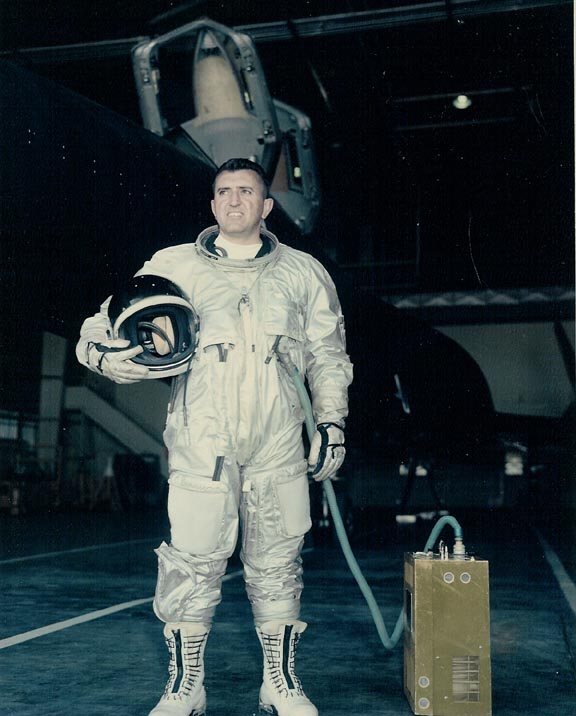


 |
 |
 |
 In 1962, the San Francisco Sector had an array of ground radars situated from Oregon to Southern Calif. They all fed radar data to the central hub at Beale AFB who bore responsibility for the security of this west coast region so that no enemy aircraft or submarine-launched missiles could penetrate that air space. One day the Beale radar detected an unknown target at over 60,000 feet and less than 200 knots. Their available interceptor aircraft could not reach that altitude to make visual identification of this possible intruder. General Tom McGehee, the sector commander, was the only person in the sector cleared for the Oxcart Blackbird program with A-12 aircraft located at Groom Lake, Nevada. General McGehee arranged for one of the A-12 Mach 3 aircraft to assist in identifying this very high altitude unknown vehicle. This was an unprecedented action. The General advised the SAGE weapons officer, Sam Ursini that a high-speed high altitude aircraft, with a call sign of Dutch, would contact him, the controller monitoring this "UNKNOWN". The Dutch aircraft checked in on radio frequency wile between Tonopah, Nevada and Sacramento California traveling at three times the speed of Beale's interceptor aircraft. Ursini vectored him toward the unknown vehicle where he made visual contact with and identified an escaped weather balloon in the jet stream. The Dutch pilot was, Mele Vojvodich, one of the first CIA A-12 flyers flew the A-12 that day.
In 1962, the San Francisco Sector had an array of ground radars situated from Oregon to Southern Calif. They all fed radar data to the central hub at Beale AFB who bore responsibility for the security of this west coast region so that no enemy aircraft or submarine-launched missiles could penetrate that air space. One day the Beale radar detected an unknown target at over 60,000 feet and less than 200 knots. Their available interceptor aircraft could not reach that altitude to make visual identification of this possible intruder. General Tom McGehee, the sector commander, was the only person in the sector cleared for the Oxcart Blackbird program with A-12 aircraft located at Groom Lake, Nevada. General McGehee arranged for one of the A-12 Mach 3 aircraft to assist in identifying this very high altitude unknown vehicle. This was an unprecedented action. The General advised the SAGE weapons officer, Sam Ursini that a high-speed high altitude aircraft, with a call sign of Dutch, would contact him, the controller monitoring this "UNKNOWN". The Dutch aircraft checked in on radio frequency wile between Tonopah, Nevada and Sacramento California traveling at three times the speed of Beale's interceptor aircraft. Ursini vectored him toward the unknown vehicle where he made visual contact with and identified an escaped weather balloon in the jet stream. The Dutch pilot was, Mele Vojvodich, one of the first CIA A-12 flyers flew the A-12 that day.
The sage (semi-automatic ground environment) divided into sectors. For example- The west coast had sectors as follows: Seattle Air Defense Sector Portland Air Defense Sector Reno air defense - Stead AFB San Francisco Air Defense Sector- Beale AFB Los Angeles Air Defense Sector-Norton AFB Phoenix Air Defense Sector-Luke AFB. Major Sam Ursini, stationed at Beale AFB-San Francisco Air Defense Sector 1961-1963, served as a sage Air Controller/Weapons Director. Air defense Headquarters liked to take guys out of the Interceptor squadrons, like Ursini, an F-101 pilot, and train them into the controller field. This was cross-training that really made a lot of sense. After a while in the controller field, they went back into cockpit jobs. The reason SAGE was semi-automatic is as follows: The system had a surveillance room and a weapons controller room. The Surveillance team took several radar sites inputs--search radars and height Finder radars--and established a radar track--done by a technician aided by the computer--thus semi-automatic- the track was then sent to the Weapons Director room, where the intercepts were conducted.
In early 1964, when Ursini joined the YF-12/SR-71 test force--it was obvious to him that with all the hundreds of intercepts scheduled for the YF-12 against our targets of choice, like the F-106 and F-104 aircraft assigned to the Test Force and a B-57 from Edwards operations--- needed a controlling agency. Since he was a former Sage controller he arranged for Los Angeles sector, southern California. Integrated Radar agency, located at Norton AFB, San Bernardino, to set up the intercepts for each sortie. He also integrated the Seven Sisters radar sites, except Beatty, into Los Angeles sector and Phoenix sector located at Luke AFB.
For every intercept sortie, either Gary Heidlebaugh (both former sage controllers) or Ursini would fly to Norton AFB in the bluebird (Cessna 310) to control the intercepts.
Ursini cleared into the Tagboard program because of this sage setup that he arranged. The authorities wanted the integrated radars of the sage system to be available to monitor the flight of the A-12 Tagboard missions. This was set up to augment the Seven Sisters radars.
On 1 May 1965, the famous speed and altitude records day, Ursini took a French official to Phoenix Air Defense Sage Sector to monitor the flights of the YF-12. The French required this to provide assurance by integrated radar coverage that the YF-12 that entered the chute for the 15/25 km and altitude records east to west and west to east was the same aircraft. This insured the Air Force not slipping in a second aircraft. The integrated radar system requirement insured coverage of the YF-12 due to the distance and large turn radius required. This enabled the French to say, "Yes the same aircraft that entered the course also exited it".
 |
 |
 |